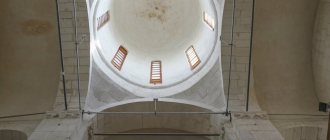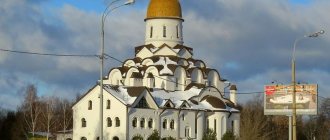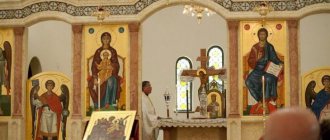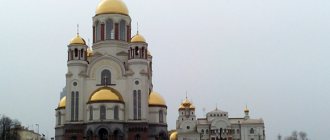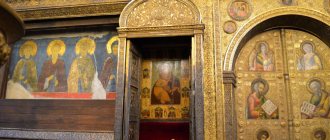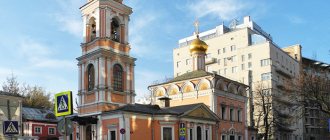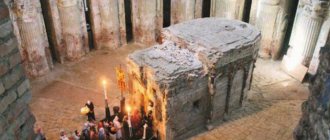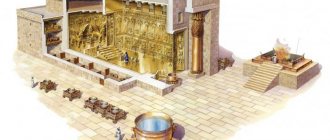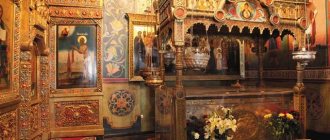| Moscow Trinity Church in Khoroshevo. Photo from the official website of the temple. |
Moscow Church of the Life-Giving Trinity in Khoroshev
(Moscow Diocese)
- Thrones:
- Life-Giving Trinity (main)
- St. Nicholas the Wonderworker
- Vmch. Theodore Stratelates
- Prophet Elijah (chapel in the refectory)
Initially, the area beyond the Khodynia River, on the road from Moscow to Zvenigorod (Zvenigorodsky tract), was called “Khodynsky Meadow”; at the turn of the 16th century, the new name “Conversations” supplanted the previous one from the documents.
Finally, in 1572, the palace village of Khoroshevo was first mentioned in documents. Presumably in 1594, Tsar Feodor Ioannovich gave Khoroshevo to his brother-in-law, Boris Godunov, and he began to renovate the estate. Construction of the temple not far from the royal traveling wooden palace supposedly began between 1596 and 1597.
In 1598, the temple was consecrated in the name of the Life-Giving Trinity. In 1650 the chapel of St. Nicholas the Wonderworker was mentioned, and in 1710 the chapel of Theodore Stratilates was mentioned.
In the 17th century the temple gained great fame; On June 13, 1619, Patriarch Filaret, who was heading to the capital, was met here. Tsar Alexei Mikhailovich repeatedly came to services in Khoroshevo. Several surrounding villages were assigned to the temple.
Initially, the temple with two chapels was surrounded by a porch. In 1745, a separate bell tower was added.
During the Patriotic War of 1812, the village occupied by the French, along with the temple, was plundered. However, church life in the temple is “supported by parish people and willing donors”
resumed quite soon. On January 27, 1813, the restored St. Nicholas chapel was consecrated, and on June 7 of the same year the main altar was consecrated.
| Moscow Trinity Church in Khoroshevo, January 2006. Photo by Yuri Krasilnikov from the site sobory.ru |
In the 1840s, instead of the porch, which was dismantled, an extensive refectory was built, connecting the temple buildings and bell towers into a single complex.
Until 1918, the temple owned 2 acres of 575 square fathoms of estate land, on which there were wooden houses of clergy and a graveyard. The staff of the clergy consisted of a priest, two psalm-readers and a malt-mealer.
In 1922, church valuables were confiscated from the temple.
In 1925, the temple was robbed three times.
On August 5, 1939, the Moscow Regional Committee of the Soviets of Workers' and Peasants' Deputies decided to close the Trinity Church. The property of the temple was partly taken away, partly looted or destroyed. The temple building was first given to a children's clinic, and after the war - to a collective farm club.
In the 1950s and 60s, the church and the adjacent site received the “Isocombinat”, later the “Offset Printing Factory” of the publishing house “Detsky Mir”, after which a significant fenced economic territory of these enterprises with various buildings for administrative and production purposes was formed to the west of the temple. This also included two one-story wooden buildings preserved from the first half of the 20th century, one of which contained the white-stone vaulted storeroom of the disappeared palace complex, preserved from the 1590s
In 1960, the territory of the collective farm, and with it the village of Khoroshevo, became part of Moscow. At the same time, the temple was placed under state protection, as evidenced by special resolution No. 1327 of the Council of Ministers of the RSFSR dated August 30, 1960.
In 1963–1964, specialists from the Soyuzrestavratsia association under the leadership of architect B.L. Altshuller, based on careful field research and study of archival sources, the main, most ancient volumes of the temple were returned to their ancient appearance. The temple was again decorated with tiers of kokoshniks. The elegant window frames, dilapidated parts of the white stone plinth and cornices, and individual elements of decorative furniture were restored. According to the new rules of scientific restoration, the masters also preserved later layers of artistic value, reflecting the main stages of construction history. Some ancient parts of the building, for example, promising portals, previously cut down or hewn, could no longer be restored with sufficient convincing, so they were recorded in situ to the extent that they could be documented.
In 1967, Mosproekt-3 restoration workshop No. 7 developed the first project for the protection zone of the monument “Church of the Life-Giving Trinity in the village of Khoroshevo”. The authors of the project were V.Ya. Libson and V. Khaslavskaya. The second project was developed in 1977 by NIPI General Plan. The author is architect N. Kuzmina. During the next stage of restoration work in the 1970s and 80s, the side entrances to the quadrangle and the original basement of the building, window openings and upper arches in the gallery were restored. At the same time, the front masonry and decorations of the facades of the refectory and bell tower were restored, and the whitewash of the ancient part was restored. The arches of the lower tier and the windows of the upper tier of the southern facade, framed by platbands with triangular sandriks, and the lower and upper arches of the northern facade were restored. Throughout the temples, flanked floors were laid out from slabs of different sizes. After the interfloor ceilings were removed, vaulted ceilings were revealed in the temple.
In 1989 it was returned to the Church. On Easter, April 30, 1989, the first service took place. For more than 10 years, the temple was restored and improved.
In 1993, several dozen old and new icons, collected with great difficulty, were stolen from the temple.
Since 1994, the clergy of the temple have been employees of the Department for External Church Relations of the Moscow Patriarchate in holy orders.
On July 5, 1998, the temple was consecrated by Patriarch Alexy II.
In the summer of 2002, the unique decor was restored - ceramic dishes in the central volume, modeled after Rhodian faience plates, once given to Boris Godunov by guests from the Ottoman Empire.
Current state
The religious building in Khoroshev was transferred to the Russian Orthodox Church in 1989. In the same year, restoration of the paintings that decorated the walls and vaults began. Icons for the new collection were collected by the whole world. People brought both old and new images.
In 1993, all the holy images were stolen. But, as once in the past, through the efforts of parishioners and benefactors, the collection of icons in the restored church was quickly replenished. And in 1997, new iconostases appeared in the temple, the images of which were painted in the Rublev style.
Iconostasis in the Church of the Life-Giving Trinity in Khoroshev
With the blessing of Patriarch Alexy II, the rectors and clergy of the Trinity parish are clergy serving in the Department for External Church Relations of the Moscow Patriarchate. Currently, the head of the parish is Metropolitan Mark of Ryazan and Mikhailovsky, who is the head of the Office of Foreign Institutions.
Restoration work in the Church of the Life-Giving Trinity was completed in 2002. Replicas of ceramic plates given to Boris Godunov by the Turks took their place in the kokoshniks of the main part of the building.
Story
The Church of the Life-Giving Trinity in Khoroshevo was built in 1596-1598 in a village owned by Boris Godunov. It served well as his country residence, where the future tsar loved to spend time; here he received foreign guests.
The temple was the second building that he erected here after his wooden palace, just 2 years after he set foot in the village. The Donskoy Monastery served as a model for construction, and its Small Cathedral served as an example. The name of the architect of the cathedral has been preserved; he was Fyodor Kon, nicknamed “the sovereign’s master.”
He is one of the few whose name is known and reflected in historical sources. Little is known about the master himself, but the list of his creations, in addition to the temple, is very impressive.
We can say for sure that he was a Russian man - this was especially emphasized in the chronicles of that time, and this was very much appreciated, because many foreign masters at that time fled to Russia in search of glory, and the Russian architect did not yield to them in anything, and even surpassed them.
Less than 10 years have passed since its construction, and Khoroshevo has faced serious trials. After the death of Boris Godunov, turmoil began, the village suffered from fires, battles with the Poles and followers of False Dmitry II.
The Poles advanced precisely through Khoroshevo, mockingly calling the formerly important village “Nekhoroshevo Monastery . The army of Vasily Shuisky was gathered near the village when it was defeated.
Only with the ascension to the throne of Mikhail Romanov did Khoroshevo return to its flourishing appearance. Khoroshevo continued to be a favorite residence; kings often visited here, engaged in the constant improvement of the temple. Distant military echoes continued to be heard here: in Khoroshevo, Poles, spies, and Lithuanian scouts were caught crossing the river in a convenient place.
In 1619, the temple welcomed the metropolitan who returned from captivity. The temple was located on the route between Moscow and Zvenigorod, pilgrims went there, and kings also visited. For a long time this place was the last stop before Moscow. There were hunting grounds nearby.
In 1666-1667, work was carried out in the temple to restore icons, icon cases, the iconostasis and the royal doors. Gradually, almost all the icons were “repaired”, and the interior of the temple was updated.
By royal decree, shrouds, fabrics, various utensils, throne clothes, lecterns were sent here, and the vessels were replaced. At that time, there was a gold embroidery workshop here. At the same time, the temple was remodeled: the facade and porch were changed, the floors were raised, and the portals were redone. Until 1676, the church was not subject to taxes, and was one of Tsar Alexei’s favorite places.
In 1688, another reconstruction took place in Khoroshevo, this time to restore the palace and the royal residence. This was also reflected in the temple: the state of affairs in Good and the abundance of lands that the parable owned did not suit Emperor Peter, and in 1700 they were partly curtailed and correctly distributed.
At that time, Khoroshevo remained an important center and retained the status of a residence, but gradually interest in it was lost, and by 1749 few people came here, but a stable school was opened on the territory of the village.
Gradually the temple deteriorated, and it again needed repair work and replacement of dilapidated shrouds and other utensils, and in 1748 a new restoration began. New utensils were given to the temple, but this was not enough. According to the documents of those years, one can trace the petitions sent to the king that the temple required more repairs. It was necessary to fix the stove, replace the iconostasis, and whitewash the walls.
By royal decision this should have been carried out, but representatives of the village only reported on the work carried out, but nothing was done. The new internal restoration took a long time and was completed only in 1763.
But the external one dragged on for a long time due to a lack of funds, workers and poor organization of work. By 1785 everything was completed, the renovation of the temple was completed and the condition of the building was considered quite good.
1812 brought a lot of destruction to the temple. The French robbed the temple, broke the doors, damaged many icons and ruined the antimension, without which the celebration of the Liturgy would have been impossible.
The loss was colossal, but thanks to the donations of people, the temple immediately began to be repaired, and the general enthusiasm after the victory made it possible to continue regular services already in 1813.
Church of the Life-Giving Trinity in Khoroshevo - project before the construction of the refectory
Rapid repairs and restoration affected the appearance of the temple. Now it has changed many times from the inside, each subsequent update radically changing the previous interior. The location at the top of the hill led to fears for some time that the temple might be destroyed by a landslide. The river bank threatened to collapse, cracks and subsidence began to appear along it.
The need for extensive work and serious financial investments did not allow the Moscow authorities to do everything necessary to strengthen the bank, but it was proposed to rebuild a new building and move all the decorations there, and demolish the temple before it collapsed.
The people decided not to give up and strengthened the shore on their own. They prevented the cracks from growing by annually strengthening the subsiding bank and planting trees. The temple was saved. Later, by 1903, surveys were being carried out to replace the old Dutch ovens with new ovens, and a new restoration was requested.
In February 1913, work began on strengthening the bank, as the threat of collapse continued to be real. Again the demolition of the temple was proposed, but this week was almost immediately abandoned as it was a historically important building. Before 1917, partial strengthening of the landslide was carried out, but the threat of revolution did not allow the situation to be radically corrected.
Until the revolution of 1917, the temple was at the peak of its prosperity, but almost immediately it was looted, although services were still held in it. In 1922, precious church utensils were removed from the temple. In 1939, the authorities closed the temple for 50 years, the building was converted into a framing workshop, and then into a children's consultation department.
After the war, a collective farm club was established here. The interior was looted, the cemetery on the territory of the temple was destroyed.
In the early 1960s, interest in historical and cultural monuments increased, and the temple was recognized as one of them. In 1964, architect V. Dregalov proposed a plan for a large-scale reconstruction, in which the aisles were connected to the refectory part of the building and could now be heated, unlike the rest of the aisles.
The unheated parts of the room were separated by a wall and were accessible only in the summer. The decoration of the temple was replaced with new ones, but in one of the chapels, the chapel of Theodore Stratelates, now isolated from the rest, the ancient decoration, icons and central iconostasis were preserved.
In the 1970s, the famous restorer and researcher of Russian architecture B. Altshuller began researching the temple. Under his leadership, the temple was partially restored to its original appearance, but some changes could not be corrected.
For example, the portals—architecturally designed entrances to the building and passages between aisles that were cut off during the reconstruction of the building—were irretrievably lost. Restoration work was carried out only in the temple, and did not affect the bell tower and refectory buildings in any way. They still housed an offset printing workshop.
The first service in the renovated church took place on April 30, 1989, on Easter.
A permanent rector was appointed to the site of the temple in 2000, and since that time the temple has launched extensive missionary activities and embarked on a path of constant development.
Architecture
The modern architectural ensemble of the Church of the Life-Giving Trinity took shape over several centuries. The following stages are distinguished in this process:
- The end of the 16th century - the construction of the main part of the temple, consisting of three parts, which were united by a common walkway (terrace). The main volume of the building is decorated with a helmet-shaped dome standing on a drum, the basis of which are five rows of kokoshniks. The same composition is repeated in the side aisles. Thus, the church in Khoroshevo has three chapters. The building is made of red brick. Its walls, today painted white, originally remained red, while the plinth and decorative details stood out for their whiteness.
- 17th century - the walkway is transformed into a porch with small windows.
- The end of the 18th century - the construction of a free-standing bell tower, completed under the direction of architect Andriyan Afanasyev in the style of Russian classicism. It is small in size, has strict and laconic lines, and is crowned with a helmet-shaped dome standing on a small drum.
- The middle of the 19th century - construction of the refectory part, which united the bell tower and the main part. The refectory is a two-pillar hall with a gable roof. The decor of its external walls visually unites the buildings of the 16th and 18th centuries. The entrance to the temple after the construction of the middle part was through the bell tower, to which two porches were added. Today the bell tower has one entrance.
- The beginning of the 21st century - the construction of an administrative building with an adjoining baptismal room. The building is designed in the style of civil architecture of pre-Petrine times.
How to get there
The convenient location of the temple allows you to get to it in any accessible way:
| Metro "Polezhaevskaya", buses 48, 155, trolleybuses 20, 21, 35, 65 to the stop on the street. Picturesque. It is mandatory to cross the highway using an underpass. | Average time: 25-35 min |
| Metro "Shchukinskaya", trams 28, 30 go to the final stop. | Average time: 30-40 min |
| Metro "Sokol" or metro "Oktyabrskoe Pole", trolleybus 59 to the final stop. | Average time: 40-45 min |
Shrines
Over the years of use of the religious building by the Soviet authorities for various economic purposes, the paintings on the walls and ceilings were almost completely lost. Some of the icons were taken away in 1922 as a result of the confiscation of church property. After the church was closed, the surviving images were stolen or hidden under layers of dust and dirt.
Temple image of the Church of the Life-Giving Trinity in Khoroshev
After the return of the temple to the Moscow Patriarchate, the restoration of the collection of icons began. It contains a large number of ancient images written in the 18th-19th centuries. The most famous and revered of them are:
- Icon of St. Nicholas the Wonderworker, painted on a metal round base in the 19th century.
- The “Oak of Mamre” is part of the tree depicted in all images of the Trinity. The icon case containing it also contains icons and a cross made of white mother-of-pearl and pink marble.
- Feodorovskaya icon of the Mother of God (19th century), to which prayers are offered for the successful course of pregnancy and the birth of a child.
- A life-size icon of Sergius of Radonezh, which is a copy from the lid of the shrine with the holy relics of the venerable man, which was made in the 19th century.
- The icon “Our Lady of Rudny” is a copy of the miraculous image of the 18th century.
Important! One of the most revered icons of the Trinity Church in Khoroshevo is the image of the Kazan Mother of God, donated by Patriarch Alexy II for the celebration of the 400th church.
Interior decoration
As far as possible, the current state of the temple preserves the original appearance of the structure. Numerous alterations and changes could not but affect the temple, but still inside it looks almost the same as it was originally conceived. Inside, the temple has a stepped vault with vocal vessels that lighten the vault and make the temple lighter in acoustics.
The temple iconostases in all chapels have been partly preserved and partly restored according to ancient records. They are located closer than before, which is why the inner surface of the altar is now larger. The temple contains icons created specifically by Vakhromeev’s workshop, and all the royal doors and other elements with wooden carvings were made by Fechner’s Moscow workshop.
In general, all the decoration of the temple and the painting were created in the canonical style; there are almost no painted icons here. The building retains its ancient spirit thanks to the repetition of ancient samples with modern materials. So here, according to the same model, the coverings for the throne and the lecterns and the Shroud were created.
Inside the temple there is a raised vault for the Crucifixion and floor icon cases. Almost the entire temple is painted; only one of the sections near the central iconostasis retains its original white walls.
Temple work
The clergy of the parish conducts not only divine services, but also conducts active educational and patronage activities.
Schedule of services
Divine services are held in the Church of the Life-Giving Trinity in Khoroshevo daily according to the following schedule:
- on weekdays and Saturdays, services are held at 8.30 and 10.30;
- in the evenings at 17.00 services are held on Friday, Saturday and Sunday;
- on Sunday there is an early service at 6.40 and a late liturgy at 8.40.
The schedule of services on the days of the patronal feasts listed below is specified on the temple website. His patronal holidays are:
- Trinity Day, celebrated on the 50th day after Easter;
- Fyodor Stratelates - February 21 and June 21;
- Prophet Elijah - August 2;
- Nicholas the Wonderworker - May 22 and December 19.
You should know that in the Church of the Life-Giving Trinity in Khoroshevo it is prohibited to film or take photographs. The clothing of both men and women during her visit should be modest, covering the knees and shoulders of women who are not allowed to wear makeup.
Activities of the parish
There is a Sunday school in Trinity Parish, which offers the following classes:
- study of God's Law;
- Church Slavonic language courses;
- handicraft circle;
- choral singing.
Adults can participate in the activities of the Sisters of Mercy Society and the Synaxis youth club, and in catechism conversations.
